The global oil coalescing filter market is valued at USD 0.6 billion in 2025 and is set to reach USD 1.1 billion by 2035, recording an absolute increase of USD 475.9 million over the forecast period. This translates into a total growth of 82.5%, with the oil coalescing filter market forecast to expand at a CAGR of 6.2% between 2025 and 2035. The overall market size is expected to grow approximately 1.8 times during the same period, supported by increasing compressed air quality requirements, growing demand for contamination-control solutions, and rising demand for efficient separation technology across petroleum processing, natural gas treatment, and industrial production applications.
The global market represents a critical segment within the filtration and fluid purification industry, driven by the superior separation efficiency characteristics of coalescing technology and the precise contamination removal capabilities of advanced filtration media. These specialized filters operate through coalescence mechanisms that combine small oil droplets into larger particles for efficient separation, providing reliable contamination removal for various fluid systems, including compressed air networks, natural gas processing facilities, and industrial production environments. The coalescing mechanism enables automatic droplet agglomeration and gravitational separation, making these devices particularly suitable for applications requiring high-purity fluids and systems demanding precise contamination control.

The oil coalescing filter market encompasses various filtration capacities, pressure ratings, and specialized designs tailored for specific separation applications. Modern oil coalescing filters incorporate advanced filtration media, optimized flow configurations, and enhanced housing designs that can operate efficiently across variable pressure conditions while maintaining consistent separation performance over extended operational periods. The integration of differential pressure monitoring, automated drain systems, and predictive maintenance features has further enhanced the value proposition of these filtration systems among facility managers seeking operational efficiency and equipment protection.
Market dynamics are significantly influenced by stringent fluid purity regulations, particularly in compressed air applications, natural gas processing, and industrial production, where contamination control and equipment protection are paramount. The industrial sector's growing focus on equipment reliability, process efficiency, and operational cost reduction has driven substantial demand for high-performance coalescing filter solutions across pneumatic systems, gas treatment installations, and process fluid networks. The growing trend toward automation and predictive maintenance has heightened the need for intelligent filtration systems that can integrate with process monitoring networks and equipment management platforms.
Consumer purchasing patterns show a marked preference for modular filtration systems that combine coalescing capabilities with versatile installation options, multiple pressure configurations, and comprehensive performance monitoring features for diverse industrial automation applications. The oil coalescing filter market has witnessed significant technological advancement in filtration media design, housing optimization, and monitoring interface systems, making these devices more suitable for demanding operational environments, extended duty cycles, and contamination-critical applications.
Between 2025 and 2030, the oil coalescing filter market is projected to expand from USD 0.6 billion to USD 0.8 billion, resulting in a value increase of USD 202.4 million, which represents 42.5% of the total forecast growth for the decade. This phase of development will be shaped by increasing fluid purity adoption, rising demand for advanced separation control solutions, and growing availability of high-efficiency coalescing technology across industrial facilities and compressed air applications.
Between 2030 and 2035, the oil coalescing filter market is forecast to grow from USD 0.8 billion to USD 1.1 billion, adding another USD 273.5 million, which constitutes 57.5% of the overall ten-year expansion. This period is expected to be characterized by the advancement of smart filtration monitoring systems, the development of energy-optimized coalescing technology for large-scale applications, and the expansion of automated separation networks across diverse industrial and process applications. The growing focus on predictive maintenance and contamination control will drive demand for advanced coalescing filter varieties with enhanced diagnostic capabilities, improved separation efficiency characteristics, and superior remote monitoring performance profiles.
| Metric | Value |
|---|---|
| Estimated Value in (2025E) | USD 0.6 billion |
| Forecast Value in (2035F) | USD 1.1 billion |
| Forecast CAGR (2025 to 2035) | 6.2% |
Between 2020 and 2024, the oil coalescing filter market experienced robust growth, driven by increasing awareness of contamination-related operational costs and growing recognition of specialized filtration systems' effectiveness in supporting efficient industrial operations across compressed air facilities and process fluid applications. The oil coalescing filter market developed as users recognized the potential for oil coalescing filters to deliver operational advantages while meeting modern requirements for precise contamination control and reliable separation performance. Technological advancement in media optimization and coalescing component development began emphasizing the critical importance of maintaining separation efficiency while extending operational life and improving user satisfaction across diverse coalescing filter applications.
Market expansion is being supported by the increasing global focus on contamination control and the corresponding shift toward high-performance filtration systems that can provide superior coalescing characteristics while meeting user requirements for precision separation operation and cost-effective fluid purification solutions. Modern facility managers are increasingly focused on incorporating filtration systems that can enhance operational reliability while satisfying demands for consistent, precisely controlled fluid purity and optimized contamination removal practices. Oil coalescing filters' proven ability to deliver separation excellence, contamination control benefits, and diverse application possibilities makes them essential components for quality-focused facilities and performance-focused industrial professionals.
The growing focus on equipment protection standards and process optimization is driving demand for high-performance coalescing filter systems that can support distinctive operational outcomes and comprehensive contamination management across compressed air applications, gas processing installations, and premium industrial systems. User preference for filtration solutions that combine functional excellence with contamination prevention is creating opportunities for innovative implementations in both traditional and emerging process automation applications. The rising influence of smart industrial technologies and advanced monitoring systems is also contributing to increased adoption of intelligent coalescing filter solutions that can provide authentic operational benefits and reliable performance monitoring characteristics.
The oil coalescing filter market is segmented by type, application, capacity range, pressure rating, and region. By type, the oil coalescing filter market is divided into mechanical coalescer, electric coalescer, and other coalescing technologies. Based on application, the oil coalescing filter market is categorized into petroleum, natural gas, compressed air, industrial production, and others. By capacity range, the oil coalescing filter market comprises low-, medium-, and high-capacity categories. By pressure rating, the oil coalescing filter market comprises low-, medium-, and high-pressure configurations. Regionally, the oil coalescing filter market is divided into North America, Europe, Asia Pacific, Latin America, the Middle East & Africa, and other regions.

The mechanical coalescer segment is projected to account for 62.4% of the oil coalescing filter market in 2025, reaffirming its position as the leading type category. Industrial operators and process professionals increasingly utilize mechanical coalescers for their proven separation efficiency characteristics, established reliability standards, and essential functionality in diverse contamination control applications across multiple industrial sectors. Mechanical coalescers' proven performance characteristics and established cost-effectiveness directly address user requirements for reliable separation control and optimal operational precision in compressed air and process fluid applications.
This type segment forms the foundation of modern contamination control performance patterns, as it represents the technology configuration with the greatest application versatility and established compatibility across multiple industrial process systems. Industrial investments in advanced coalescing technology and contamination optimization continue to strengthen adoption among efficiency-focused users. With facility managers prioritizing contamination prevention and separation reliability, mechanical systems align with both performance objectives and operational requirements, making them the central component of comprehensive fluid purification strategies.
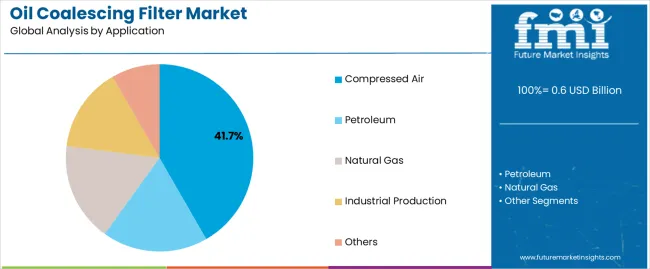
Compressed air is projected to represent 41.7% of the oil coalescing filter market in 2025, underscoring its critical role as the primary application for efficiency-focused users seeking superior contamination control benefits and enhanced pneumatic system management credentials. Compressed air users and facility operators prefer compressed air applications for their established operational requirements, proven contamination demand, and ability to maintain exceptional separation precision while supporting versatile system coverage during diverse industrial activities. Positioned as essential applications for efficiency-focused facility managers, compressed air offerings provide both operational excellence and contamination optimization advantages.
The segment is supported by continuous improvement in pneumatic technology and the widespread availability of established compressed air standards that enable performance assurance and premium positioning at the facility level. Compressed air users are optimizing filter selections to support system-specific applications and comprehensive pneumatic automation strategies. As industrial automation technology continues to advance and facilities seek efficient contamination control methods, compressed air applications will continue to drive market growth while supporting operational efficiency and fluid purity optimization strategies.
The oil coalescing filter market is advancing rapidly due to increasing contamination control adoption and growing need for intelligent separation solutions that emphasize superior coalescing performance across industrial segments and process automation applications. The oil coalescing filter market faces challenges, including competition from conventional filtration technologies, installation complexity considerations, and initial investment cost factors affecting adoption rates. Innovation in separation efficiency enhancement and advanced coalescing systems continues to influence market development and expansion patterns.
The growing adoption of oil coalescing filters with process automation connectivity and smart facility integration is enabling users to develop contamination control strategies that provide distinctive monitoring benefits while commanding automated operation and enhanced real-time separation analysis characteristics. Smart industrial applications provide superior operational consistency while allowing more sophisticated contamination optimization features across various process categories. Users are increasingly recognizing the operational advantages of intelligent filter positioning for comprehensive process control outcomes and technology-integrated facility management.
Modern oil coalescing filter manufacturers are incorporating advanced contamination sensors, real-time performance monitoring capabilities, and separation analytics systems to enhance operational precision, improve filtration efficiency effectiveness, and meet industrial demands for intelligent contamination control solutions. These systems improve operational effectiveness while enabling new applications, including continuous contamination monitoring programs and automated optimization protocols. Advanced analytics integration also allows users to support proactive contamination positioning and performance assurance beyond traditional filtration operation requirements.
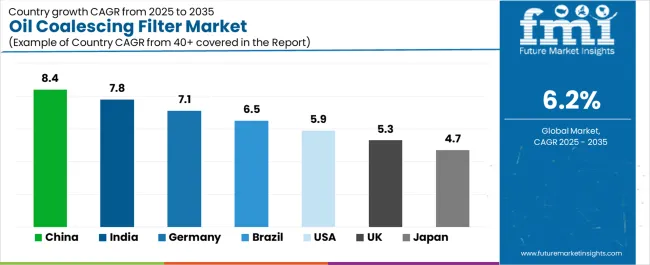
| Country | CAGR (2025-2035) |
|---|---|
| China | 8.4% |
| India | 7.8% |
| Germany | 7.1% |
| Brazil | 6.5% |
| USA | 5.9% |
| UK | 5.3% |
| Japan | 4.7% |
The oil coalescing filter market is experiencing robust growth globally, with China leading at a 8.4% CAGR through 2035, driven by the expanding industrial sector, growing process automation requirements, and increasing adoption of advanced contamination control systems. India follows at 7.8%, supported by rising industrialization, expanding manufacturing industry, and growing acceptance of filtration technologies. Germany shows growth at 7.1%, emphasizing established engineering standards and comprehensive process automation development. Brazil records 6.5%, focusing on industrial modernization and contamination control growth. The USA demonstrates 5.9% growth, prioritizing advanced industrial technologies and process optimization.
The report covers an in-depth analysis of 40+ countries, top-performing countries are highlighted below.
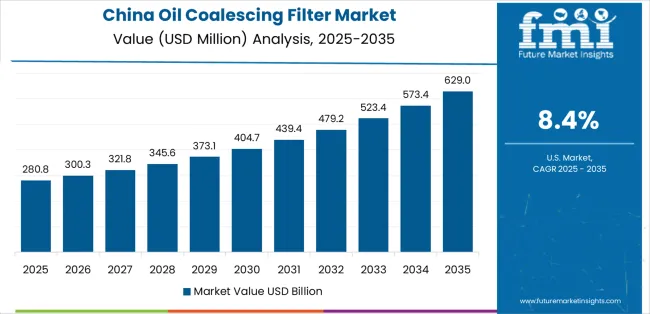
China is projected to exhibit exceptional growth with a CAGR of 8.4% through 2035, driven by the country's rapidly expanding industrial sector, favorable government policies toward contamination control modernization, and initiatives promoting process automation technologies across major manufacturing regions. China's position as a global industrial hub and increasing focus on quality control systems are creating substantial demand for high-quality oil coalescing filters in both domestic and export markets. Major industrial equipment companies and process distributors are establishing comprehensive filtration capabilities to serve growing demand and emerging automation opportunities.
India is expanding at a CAGR of 7.8%, supported by rising industrialization investment, growing contamination consciousness, and expanding equipment distributor capabilities. The country's developing industrial infrastructure and increasing investment in process technologies are driving demand for coalescing filters across both traditional and modern industrial applications. International industrial equipment companies and domestic distributors are establishing comprehensive operational networks to address growing market demand for contamination control devices and efficient filtration solutions.
Germany is projected to grow at a CAGR of 7.1% through 2035, supported by the country's mature engineering standards, established process automation regulations, and leadership in contamination control technology. Germany's sophisticated industrial standards and strong support for advanced filtration systems are creating steady demand for both traditional and innovative coalescing filter varieties. Leading industrial equipment manufacturers and specialty distributors are establishing comprehensive operational strategies to serve both domestic markets and growing export opportunities.
Brazil is projected to grow at a CAGR of 6.5% through 2035, driven by the country's focus on industrial development, process modernization growth, and growing automation distributor capabilities. Brazilian industrial users and manufacturing facilities consistently seek efficiency-focused equipment that enhances operational performance and supports modernization excellence for both traditional and modern industrial applications. The country's position as a Latin American industrial leader continues to drive innovation in specialized contamination control applications and process automation standards.
The USA is projected to grow at a CAGR of 5.9% through 2035, supported by the country's focus on industrial technology advancement, contamination control optimization, and advanced process system integration requiring efficient separation solutions. American industrial users and automation-focused facilities prioritize performance reliability and contamination precision, making specialized oil coalescing filters essential components for both traditional and modern process automation applications. The country's comprehensive industrial technology leadership and advancing quality patterns support continued market expansion.
The UK is projected to grow at a CAGR of 5.3% through 2035, supported by established industrial standards, mature automation markets, and focus on contamination control across manufacturing and process sectors. British industrial users and automation professionals prioritize quality performance and operational consistency, creating steady demand for premium filtration solutions. The country's comprehensive market maturity and established industrial practices support continued development in specialized applications.
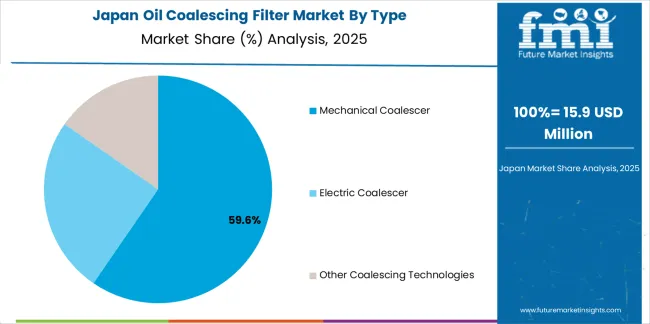
Japan is projected to grow at a CAGR of 4.7% through 2035, supported by the country's focus on precision engineering, operational excellence, and advanced technology integration requiring efficient contamination control solutions. Japanese industrial users and automation-focused facilities prioritize technical performance and engineering precision, making specialized oil coalescing filters essential components for both traditional and modern process automation applications. The country's comprehensive engineering leadership and advancing precision patterns support continued market expansion.
What is the market split by country in Europe?

The Europe oil coalescing filter market is projected to grow from USD 168.3 million in 2025 to USD 294.7 million by 2035, recording a CAGR of 5.7% over the forecast period. Germany leads the region with a 43.2% share in 2025, moderating slightly to 42.8% by 2035, supported by its strong engineering traditions and demand for premium, precision-manufactured filtration solutions. The United Kingdom follows with 24.1% in 2025, easing to 23.6% by 2035, driven by a mature process automation market and focus on contamination control and quality performance. France accounts for 14.7% in 2025, rising to 15.2% by 2035, reflecting steady adoption of process automation technologies and contamination optimization. Italy holds 8.9% in 2025, expanding to 9.6% by 2035 as industrial modernization and specialty automation applications grow. Spain contributes 5.8% in 2025, growing to 6.1% by 2035, supported by expanding industrial development and contamination awareness modernization. The Nordic countries rise from 2.1% in 2025 to 2.3% by 2035 on the back of strong quality consciousness and advanced industrial methodologies. BENELUX remains at 1.2% share across both 2025 and 2035, reflecting mature, efficiency-focused industrial markets.
The oil coalescing filter market is characterized by competition among established industrial equipment manufacturers, specialized filtration companies, and integrated process solution providers. Companies are investing in advanced coalescing technologies, specialized media engineering, product innovation capabilities, and comprehensive distribution networks to deliver consistent, high-quality, and reliable filtration systems. Innovation in separation efficiency optimization, media advancement, and contamination-focused product development is central to strengthening market position and customer satisfaction.
Parker leads the oil coalescing filter market with 18.7% share with a strong focus on filtration technology innovation and comprehensive industrial solutions, offering commercial and industrial systems with an emphasis on performance excellence and engineering heritage. Atlas Copco provides integrated process automation with a focus on compressed air applications and precision contamination networks. NiGen International delivers comprehensive filtration technology solutions with a focus on industrial positioning and operational efficiency. Brother Filtration specializes in comprehensive coalescing systems with an focus on separation applications. Suburban Manufacturing Group focuses on comprehensive industrial equipment with advanced design and premium positioning capabilities.
The success of oil coalescing filters in meeting process automation demands, contamination control requirements, and operational integration will not only enhance industrial performance outcomes but also strengthen global filtration technology manufacturing capabilities. It will consolidate emerging regions' positions as hubs for efficient coalescing filter production and align advanced economies with comprehensive automation systems. This calls for a concerted effort by all stakeholders -- governments, industry bodies, manufacturers, distributors, and investors. Each can be a crucial enabler in preparing the oil coalescing filter market for its next phase of growth.
How Governments Could Spur Local Production and Adoption?
How Industry Bodies Could Support Market Development?
How Distributors and Industrial Equipment Players Could Strengthen the Ecosystem?
How Manufacturers Could Navigate the Shift?
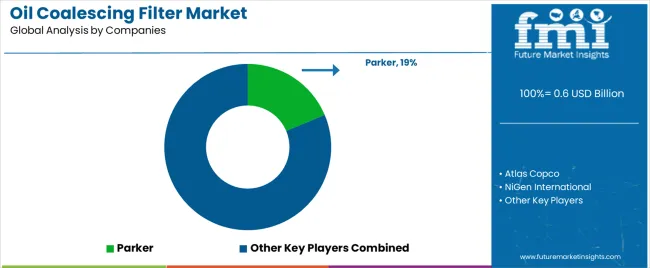
| Items | Values |
|---|---|
| Quantitative Units (2025) | USD 0.6 billion |
| Type | Mechanical Coalescer, Electric Coalescer, Other Coalescing Technologies |
| Application | Petroleum, Natural Gas, Compressed Air, Industrial Production, Others |
| Capacity Range | Low Capacity, Medium Capacity, High Capacity |
| Pressure Rating | Low Pressure, Medium Pressure, High Pressure |
| Regions Covered | North America, Europe, Asia Pacific, Latin America, Middle East & Africa, Other Regions |
| Countries Covered | China, India, Germany, Brazil, United States, United Kingdom, Japan, and 40+ countries |
| Key Companies Profiled | Parker, Atlas Copco, NiGen International, Brother Filtration, Suburban Manufacturing Group, and other leading oil coalescing filter companies |
| Additional Attributes | Dollar sales by type, application, capacity range, pressure rating, and region; regional demand trends, competitive landscape, technological advancements in filtration engineering, coalescing optimization initiatives, contamination enhancement programs, and premium product development strategies |
The global oil coalescing filter market is estimated to be valued at USD 0.6 billion in 2025.
The market size for the oil coalescing filter market is projected to reach USD 1.1 billion by 2035.
The oil coalescing filter market is expected to grow at a 6.2% CAGR between 2025 and 2035.
The key product types in oil coalescing filter market are mechanical coalescer, electric coalescer and other coalescing technologies.
In terms of application, compressed air segment to command 41.7% share in the oil coalescing filter market in 2025.






Full Research Suite comprises of:
Market outlook & trends analysis
Interviews & case studies
Strategic recommendations
Vendor profiles & capabilities analysis
5-year forecasts
8 regions and 60+ country-level data splits
Market segment data splits
12 months of continuous data updates
DELIVERED AS:
PDF EXCEL ONLINE
Oil-immersed Iron Core Series Reactor Market Size and Share Forecast Outlook 2025 to 2035
Oil and Gas Sensor Market Forecast Outlook 2025 to 2035
Oil Packing Machine Market Forecast and Outlook 2025 to 2035
Oil and Gas Pipeline Coating Market Forecast and Outlook 2025 to 2035
Oilfield Scale Inhibitor Market Size and Share Forecast Outlook 2025 to 2035
Oil-in-Water Anionic Emulsifier Market Size and Share Forecast Outlook 2025 to 2035
Oil and Gas Field Services Market Size and Share Forecast Outlook 2025 to 2035
Oil Control Shampoo Market Size and Share Forecast Outlook 2025 to 2035
Oil Expellers Market Size and Share Forecast Outlook 2025 to 2035
Oilfield Stimulation Chemicals Market Size and Share Forecast Outlook 2025 to 2035
Oiler Kits Market Size and Share Forecast Outlook 2025 to 2035
Oil Pressure Sensor Market Size and Share Forecast Outlook 2025 to 2035
Oil Filled Power Transformer Market Size and Share Forecast Outlook 2025 to 2035
Oily Skin Control Products Market Analysis - Size and Share Forecast Outlook 2025 to 2035
Oil Immersed Shunt Reactor Market Size and Share Forecast Outlook 2025 to 2035
Oil Country Tubular Goods Market Size and Share Forecast Outlook 2025 to 2035
Oil Filled Distribution Transformer Market Size and Share Forecast Outlook 2025 to 2035
Oilfield Communications Market Size and Share Forecast Outlook 2025 to 2035
Oil & Gas Electrification Market Size and Share Forecast Outlook 2025 to 2035
Oil and Gas Accumulator Market Size and Share Forecast Outlook 2025 to 2035

Thank you!
You will receive an email from our Business Development Manager. Please be sure to check your SPAM/JUNK folder too.
Chat With
MaRIA